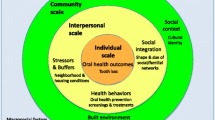Abstract
Recruiting and enrolling low income, racially and ethnically diverse adolescents into research studies can be a challenge. This paper details our research team’s methodology in the recruitment and enrollment of low income and racially/ethnically diverse adolescents in three cities as part of a broader study to understand adolescent perceptions of a health risks. Our team used Florida’s Medicaid and Children’s Health Insurance Plan administrative databases to identify a sample of adolescents for focus group participation. Utilizing geographic information systems software we generated maps of racial and ethnic group clusters in three cities and identified community centers within each cluster to hold the focus groups. We mailed initial focus group introduction letters, conducted follow-up phone calls for recruitment and further implemented techniques to optimize participant confidentiality and comfort. We enrolled 35 participants for eight focus groups in three cities at a total cost of $264 per participant, including personnel, materials, travel, and incentives costs. As a result of our efforts, groups were fairly evenly distributed by both race and gender. Administrative databases provide opportunities to identify and recruit low income and racially/ethnically diverse adolescents for focus groups that might not otherwise have the opportunity to participate in research studies. It is important that researchers ensure these populations are represented when conducting health assessment tool evaluations.

Similar content being viewed by others
References
UyBico, S., Pavel, S., & Gross, C. (2007). Recruiting vulnerable populations into research: A systematic review of recruitment interventions. Journal of General Internal Medicine, 22, 852–863.
Corbie-Smith, G. (2004). Minority recruitment and participation in health research. North Carolina Medical Journal, 65, 385–387.
Blanton, S., DM, M., Prettyman, M., McCulloch, K., Redmond, S., & Light, K. (2006). Lessons learned in participant recruitment and retention: The EXCITE trial. Physical Therapy, 86, 1520–1533.
Akers, A. Y., Gold, M. A., Coyne-Beasley, T., & Corbie-Smith, G. (2012). A qualitative study of rural black adolescents’ perspectives on primary STD prevention strategies. Perspectives on sexual and reproductive health, 44(2), 92–99.
Balch, G. I. (1998). Exploring perceptions of smoking cessation among high school smokers: Input and feedback from focus groups. Preventive Medicine, 27(5 Pt 3), A55–A63.
Gonzales, R., Anglin, M. D., Beattie, R., Ong, C. A., & Glik, D. C. (2012). Understanding recovery barriers: Youth perceptions about substance use relapse. American Journal of Health Behavior, 36(5), 602–614.
Hosek, S., Brothers, J., & Lemos, D. (2012). Adolescent medicine trials network for HIVAI. What HIV-positive young women want from behavioral interventions: a qualitative approach. AIDS Patient Care and STDs, 26(5), 291–297.
Krueger, R. A., & Casey, M. A. (2009). Focus groups: A practical guide for applied research.In Richard A. Krueger, Mary Anne Casey (Eds.), (4th ed.). Los Angeles: SAGE.
Hyde, A., Howlett, E., Brady, D., & Drennan, J. (2005). The focus group method: Insights from focus group interviews on sexual health with adolescents. Social Science and Medicine, 61, 2588–2599.
ArcGIS desktop: Release 10 [computer program]. Redlands, CA2011.
Morgan, D. L. (1998). Practical strategies for combining qualitative and quantitative methods: Applications to health research. Qualitative Health Research, 8(3), 362–376.
Clarke, A. (1999). Focus group interviews in health-care research. Professional Nurse (London, England), 14(6), 395–397.
Strickland, C. J. (1999). Conducting focus groups cross-culturally: Experiences with Pacific Northwest Indian people. Public Health Nursing, 16(3), 190–197.
Davis, R. E., Couper, M. P., Janz, N. K., Caldwell, C. H., & Resnicow, K. (2010). Interviewer effects in public health surveys. Health Education Research, 25(1), 14–26.
Coker, T. R., Sareen, H. G., Chung, P. J., Kennedy, D. P., Weidmer, B. A., & Schuster, M. A. (2010). Improving access to and utilization of adolescent preventive health care: The perspectives of adolescents and parents. Journal of Adolescent Health, 47(2), 133–142.
Mendez-Luck, C. A., Trejo, L., Miranda, J., Jimenez, E., Quiter, E. S., & Mangione, C. M. (2011). Recruitment strategies and costs associated with community-based research in a Mexican-origin population. The Gerontologist, 51(Suppl 1), S94–S105.
Boyle, R. G., Enstad, C., Asche, S. E., Thoele, M. J., & Sherwood, N. E. (2007). Evaluating strategies and costs to recruit smokeless tobacco users. Addictive Behaviors, 32(12), 3088–3092.
Kelly, P. J., Ahmed, A., Martinez, E., & Peralez-Dieckmann, E. (2007). Cost analysis of obtaining postintervention results in a cohort of high-risk adolescent girls. Nursing Research, 56(4), 269–274.
Duda, C., Mahon, I., Chen, M. H., et al. (2011). Impact and costs of targeted recruitment of minorities to the National Lung Screening Trial. Clinical Trials, 8(2), 214–223.
Hinshaw, L. B., Jackson, S. A., & Chen, M. Y. (2007). Direct mailing was a successful recruitment strategy for a lung-cancer screening trial. Journal of Clinical Epidemiology, 60(8), 853–857.
Keyzer, J. F., Melnikow, J., Kuppermann, M., et al. (2005). Recruitment strategies for minority participation: Challenges and cost lessons from the POWER interview. Ethnicity and Disease, 15(3), 395–406.
Margitić, S., Sevick, M. A., Miller, M., et al. (1999). Challenges faced in recruiting patients from primary care practices into a physical activity intervention trial. Preventive Medicine, 29(4), 277–286.
Acknowledgments
This project was funded in part by the Clinical and Translational Science Institute, University of Florida UL1-RR029890; David Nelson, MD, Principal Investigator; Elizabeth Shenkman, PhD, Co-Investigator.
Author information
Authors and Affiliations
Corresponding author
Rights and permissions
About this article
Cite this article
Hinojosa, M.S., Kadivar, H., Fernandez-Baca, D. et al. Recruiting Low Income and Racially/Ethnically Diverse Adolescents for Focus Groups. Matern Child Health J 18, 1912–1918 (2014). https://doi.org/10.1007/s10995-014-1435-x
Published:
Issue Date:
DOI: https://doi.org/10.1007/s10995-014-1435-x



